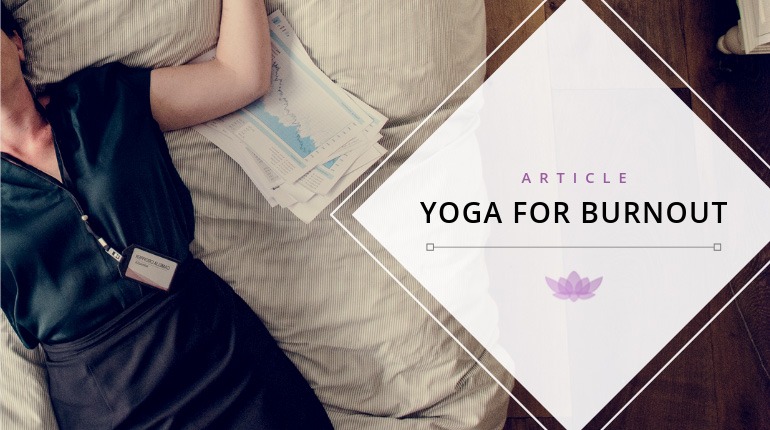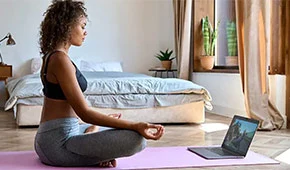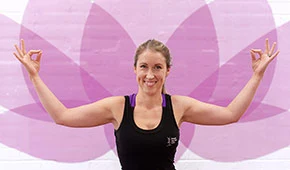
Use the quick links below to navigate this article:
– Introduction
– What is stress and how does it link to burn out?
– The eastern approach to healing
– How can yoga help?
– Asana for burnout
– Pranayama for burnout
– Other practices for burnout
– Conclusion
Introduction
In our overstimulated world, we are often dealing with the pressures of huge workloads, paying bills, looming deadlines, being caught up in the daily rush hour commute and traffic jams, as well as underlying fears and worries such as family difficulties, losing a job or the people we love. These are just a handful of things we could be dealing with daily, keeping our bodies and minds constantly “on-the-go.” Even when we think we’re stopping to rest, most of us are filling up space with watching TV, scrolling through social media or planning our next activity. The body perceives these minor hassles as stress. Living this way, in a continuous state of doing, leaves us in a consistent low-level state of stress, our bodies feel under constant attack, and as a society, we have become accustomed to thinking it is ‘normal’ to live this way. Stress is your body’s way of responding to any kind of demand or threat. It is unable to differentiate between real or imagined danger, it is all sensed the same, and as a result, your body’s defences kick into high gear in a rapid, automatic process (sympathetic nervous system- SNS) known as the “stress response” or “flight-or-flight.” According to the World Health Organisation, it is estimated that “by 2020, stress-related disorders will be the second leading cause of disabilities in the world”.
Yoga is a medically recommended form of treatment for reducing the feelings of stress, helping to release the body and mind from a state of “fight-or-flight”, and bringing it into a state of “rest-and-digest”, when the parasympathetic nervous system (PNS) is engaged. The “rest-and-digest” state is vital to the human body in order for healing and regeneration to occur, where the body performs activities such as digesting, detoxifying, eliminating and building immunity. Since the effectiveness of yoga tends to increase the longer you continue with it, it offers a path to steady, gradual, improvement.
What is stress and how does it link to burn out?
Not all stress is bad for you. Your body is designed to use your stress response to protect you from danger and give you that extra boost of adrenaline you need during that presentation, the last 100 yards of a race, or to jump out of the way of a speeding car. Living in a state of constant ‘alert’ mode though, due to low-level stressors over a prolonged period of time, can take its toll on the body and causes long term physical and psychological health problems.
Research suggests that chronic stress contributes to high blood pressure, promotes the formation of artery-clogging deposits, and causes brain changes that may contribute to anxiety, depression, and addiction. While there is little evidence to support the term ‘burn out’ as a medically accepted condition, Mind-body-health suggest that burnout syndrome is a set of physical and mental symptoms. These include exhaustion/fatigue, headaches, depression, anxiety, insomnia, excessive sleeping and/or dysregulated body clock, chronic pain, abnormal hormone levels (including thyroid, cortisol and testosterone), suppressed or altered immunity, including susceptibility to viral infections and increased allergic symptoms, to name but a few. These are all also recognised symptoms of stress. Denise Meredith, a victim of burn out, describes it as a feeling of “The very smallest of physical tasks leaving me feeling exhausted. Even just the slightest of mental stimulation or agitation, can leave me feeling deeply overwhelmed and unable to cope.”
The term ‘burn out’ is technically considered a work-related condition as a result of feeling overworked and ineffective, to the point of exhaustion. A recent Gallup study of nearly 7,500 full-time employees, found that 23% reported feeling burned out at work very often or always, while an additional 44% reported feeling burned out sometimes. The costs to health-care is an estimated $125-190 billion a year, according to a Harvard business review article and a 2017 study in the journal PLoS One cited major health risks related to job burnout, like type 2 diabetes, coronary heart disease, gastrointestinal issues, high cholesterol and even death for those under the age of 45.
The Eastern approach to healing
There is currently very little medical understanding of the condition “burn out” and no allopathic treatment available, other than the offering of anti-depressants. Anti-depressants are not appropriate, as depression is merely a possible side effect of the underlying problem of burn out, not to mention to list of negative side effects from consuming anti-depressant tablets.
In Ayurveda (The Eastern approach to medicine, known as ‘The Science of Life’) an imbalance in the function of the adrenals, is associated with an imbalance in vata energy. There are 2 types of vata energy; prana vata which moves up into the head to support the functions of the nervous system, and apana vata, which moves down the body towards the pelvis, supporting the adrenal, elimination and reproductive functions.
Ayurveda suggests that avoiding coffee and alcohol, regulating meal times, choosing complex carbohydrates and taking herbs such as ginseng can all help to boost energy levels in burn out sufferers.
How can yoga help?
Yoga is a holistic practice that encompasses the body, mind and spirit. The practice of yoga can help to unravel areas of your life where without realising it, you have become out of balance. Yoga works to guide you through ‘Svadhayaya’ translated as ‘self-study’ and enquiry, to bring you on a path that is most suited to your needs. It brings to the surface, knowledge about over or under stimulated Chakras (energy centres) and Nadis (energy channels) which inhibit or poorly direct the flow of Prana (energy or life force) and can cause a sense of feeling stuck or stagnant. With self-study and the quietening of the mind that comes from practising yoga, you are more easily able to tune into messages you may have previously been unable to hear, due to background noise. The practice of yoga, can aid a sufferer in being able to notice when they are living a life of imbalance, and potentially answer questions about why they have become burnt out in the first place, allowing them to gain more insight and a better understanding, to aid in overcoming the sense of confusion often felt by a sufferer. A self-enquiry practice may also help prevent a sufferer from coming down the path of ‘burn out’ again in future, through noticing how they are living their daily life and making the appropriate adjustments to live in a more balanced existence.
Yoga is an umbrella term that includes a number of systematic actions to essentially bring happiness, balance and sense of calm and connection, which in turn aids to bring down cortisol levels in the body, and encourage a person out of a state of SNS living, and into a more balanced state of being.
Important considerations for an effective yoga class for burn out sufferers
When teaching yoga classes, it is helpful to notice signs of a practitioner in ‘constant alert” such as, but not limited too;
• Lack of ability to focus
• Rushing to the end point and not exploring on the way
• Movements being large, rather than subtle/refined as interoception difficult.
• Muscle tightness from holding on and preparing for physical protection from danger, tight psoas from the habitual ‘curl in’ response.
• Fingers may be tight or clenched when lying down or sitting, toes may be clenched when standing, and jaw may grip and clench throughout.
• Jerky movements.
• Dizziness or nausea when moving from high to low in forward folds.
• Base of the skull compressed with a slight upward tilt of the head, relating to tension of the jaw and throat.
• Easily distracted, picking nails, sounds outside etc.
• Shoulders pulled up to ears – shallow upper chest only breathing.
• Resistance to stillness.
• Self-criticism coming from a fear-based or negative inner voice.
• Feeling overwhelmed.
• Display low tolerance to pain therefore heightened reactions to sensations felt during asana.
In delivering yoga to students, Charlotte Watts says “Stress has us acting from a fear-based and therefore negative outlook, so fostering a sense of safety through kind attention can help draw us round to seeing things more positively.” As a teacher, it is important to deliver the content of your classes in a slow, kind, sensitive, gentle and appropriate manner, so students feel safe and relaxed, in order to avoid heightening any sensations of burn out, that is already being felt.
Relaxation is probably the most important part of a class, for sufferers of burn out. It is only when in this state that healing can occur, as it is the optimum environment for cellular function. Therefore, Savasana (corpse pose), both traditional and with variations of the arms and legs for hip, shoulder and thoracic spine opening, offer the sufferer space for relaxation, as well as Yoga Nidra, a deeply restorative form of relaxation.=
Asana for burnout
The 3rd of the 8 limbs of Patanjali’s yogic path. An asana practice includes physical body movements or “postures” that work to stimulate the body from the inside out, to aid in removing blockages or obstacles in the body such as disease, sluggishness and dullness, to allow the free flow of prana throughout. In the case of burn out, small, gentle movements are more appropriate than physically challenging postures that improve muscle strength and toning at the early stages of recovery, in order to not heighten any sense of fatigue felt.
With less focus on the muscles and skeletal structure in yoga for burn out, we would work on more subtle movements that are focusing on activating the bodies systems. Systems such as the nervous system to activate the PNS, the vagus nerve to manage stress response more efficiently, the endo and exocrine systems to manage the hormones secreted into the blood to stabilise energy levels, the lymphatic system for effectively flushing toxins to the areas of the body needed to for excretion, and the immune system to effectively fight off antibodies and strengthen the body’s immune response. The adrenals glands also require “toning” in order for the hormones secreted to initiate a PNS or SNS response to be picked up. Well-functioning adrenals allow the body to move efficiently between a state of PNS & SNS as needed, which is often what is lacking in the case of burnout.
When practising asana for burnout it’s important to move slowly in and out of postures. If dizziness is felt coming out of a pose then resting with the head lower than the heart is recommended. Supported postures or hanging, are advisable to reduce the effort required to achieve benefits, such as those achieved in the use of inversions.
Practice Video: Yoga for mental health
Pranayama for burnout
The 4th of Patanjali’s 8 limbed path. Pranayama offers us breathing practices that are beneficial for stress and anxiety relief and bringing practitioners out of heightened ‘fight or flight’ living. Steady breathing and long, smooth exhales, activate the parasympathetic nervous system (PNS) to take over, and invite the body into a more relaxed state. The pranayama listed below work to gently improve the cardiovascular system which works alongside the respiratory system to improve overall health, improving the vegal tone, and therefore decreasing the effects of stress and anxiety in a burnout sufferer.
The average human breathes erratically using only approximately 10% of their available diaphragm range. This only allows us sufficient oxygen to survive, but not to thrive. When a person is upset, stressed or anxious, the abdomen tenses and prevents the muscles required for diaphragmatic breathing to take place, from working effectively. This results in the smaller, secondary muscles, only designed to shoulder 20% of the bounden, to take over. This can lead to chronic tension in the neck and shoulder and lead to fatigue, resulting in continued shallow breathing through lack of available energy.
Pranayama is accessible to all bodies and helpful for those sufferers who feel asana is initially too much for their physical body to cope with just yet.
Pranayama Practices for Burnout – Coherent breathing/ equal breath – This can be practised to help optimise the gaseous exchange throughout the system, which can allow the nervous system to relax. The breath is regulated to a rhythm of, inhaling for a count of 6 and exhaling for a count of 6. One complete breath is 12 seconds long, thus reducing the breathing rate to 5 breaths per minute. This breath work can be repeated as many times as is appropriate for the practitioner, but in the case of burn out sufferers, starting with a shorter count may be more appropriate in order to not create any strain.
Each inhale lightly activates the SNS and the exhale activates the PNS, so a breath practice focusing on a longer exhale, is an excellent tool for burnout sufferers.
Nadi Shodona/Alternate nostril breathing – This can be used to balance both the left and right hemispheres of the brain and reduce the feeling of anxiety and stress. Nadi Shodana balances both hemispheres of the brain and promotes stress and anxiety relief.
Practice Video: Nadi Shodona and Meditation
Sheetali & Sheetkari/cooling breath – Both of these are variations of a cooling breath, to lower the heat in the body, and have a tranquillising and calming effect.
• Sheetali – Sitting tall with the eyes closed, extend the tongue out of the mouth and curl into a tube, inhale a full breath through the tongue, creating a hissing sound. Bring the tongue back into the mouth and exhale fully through the nose.
• Sheetkari – Sitting tall with the eyes closed, lightly clench the teeth and part the lips, inhale through the teeth creating a hissing sound. Close the lips and exhale fully through the nose.
Both variations can be practised between 5-15 rounds depending on the practitioner. Contraindications are that this is not to be done by those with heart disease, asthma, bronchitis, low blood pressure, pregnancy or constipation. Only to be practised in hot weather and where the air is not heavily polluted, avoid practising in cold weather.
3 part breath – A excellent pranayama to increase awareness of the depth of breath and in grounding and calming the body and mind. This pranayama is especially helpful in burnout, as it can be done both seated and laying down. The hands can be first placed onto the belly by choice, or rest by the sides of the body. Take a deep inhale through the nose filling up the belly space, and exhale the breath from the belly fully through the nose, repeat. Moving the hands to the ribs, take a deep inhale filing up the belly first and then up into the ribs, then exhale from the belly followed by the ribs through the nose, and repeat. Finally moving the hands to the upper chest and inhale fully, first filling up the belly, then the ribs and finally the upper chest and collarbones, then exhaling fully from the belly, ribs and then the upper chest through the nose, and repeat. All the while feeling the body rise and fall beneath the palms if you choose.
Bhramari/Humming or bee breath – This breathing exercise reduces tension and stress and the vibrations create a soothing effect on the mind. The most appropriate variation of Bhramari for burnout sufferers would be to sit tall, the option to rest against a wall, eyes closed and lips and teeth gently joined together, with the tongue touching the back of the teeth, with or without the use of the thumbs in the ears and fingertips on the head. First, inhale, then fully exhale until the abdomen is empty of air while making a humming sound with the throat. 5 rounds are appropriate, if accessible for the practitioner. Contraindications include ear infections, and in the case of burnout sufferers, the option to not use the hands on the head as keeping the arms up can be too tiring.
Other practices for burnout
Dharana – The practice of concentration leading to meditation, the 6th limb, will help draw the practitioner into a more focused state of mind, helping to relieve feelings of anxiety and overwhelm, when they’re more able to focus clearly on one thing at a time.
Dharana is about fixing the mind to one specific point, like part of the body, a chakra, a statue or another object. The object is not of extreme importance, the purpose is to quiet the mind with this total concentration. When we focus the mind intensely into one point, the rest of the mind tends to quiet down, leaving less room for other thoughts, memories, and planning, that the mind tends to otherwise be busy with, that could heighten feelings of stress and lead to burn out.
The mind is like a muscle we can train, and it’s not beyond our control that the thoughts just come and take us away with them. We are in control, and Dharana is one way we can practice this control. Here, a meditation practice could be beneficial, in order to achieve a more relaxed and focused state, as the PNS is activated and the mind becomes quieter. Examples of the object of the Meditation for burnout sufferers could be:
• Earthing/grounding, focusing on the Mulahara chakra
• Compassion/heart opening, focusing on using Anahata chakra.
• A full chakra meditation for balance, encompassing a focus on all 7 Charkas in sequence.
Mindfulness – The aim of mindfulness is not to try to empty the mind of thoughts, but to understand how the mind works. Seeing how it unwittingly ties itself in knots to create anxiety, stress, unhappiness and exhaustion.
Mindfulness is the act of consciously paying your full attention to whatever activity or feeling you’re engaged in or noticing, without criticism or judgement, simply noticing it for what it is. Mindfulness is encouraged to be practised daily in order to rest a person’s mind and relieve the feelings of stress, which can lead to burning out. Mindfulness daily, alongside a regular meditation practice, brings a practitioner into a more present state of living and can be preventative in assisting a burnout sufferer from relapse in future.
Self-compassion – In our goal-orientated society which is constantly demanding more and more of a person to succeed and achieve, we can often be left living in a ‘comparing mind’ state. Comparing and judging oneself against others for a sense of one-upmanship. The potential this offers for psycho-social stress is extremely damaging.
Self-esteem can be knocked at any time, as the conditions on which it is based, fluctuate from one moment to the next. Compassion though, is always available, as it does not depend on external factors, but rather a person’s openness to recognising their suffering, with kindness and compassion towards themselves.
A self-compassion meditation would be appropriate for burnout sufferers to work towards, removing any felt sense of blame and leading towards a more compassionate life of self-care in balance.
Sound/mantra – A recent study on singing for an hour in a choir setting had a variety of positive effects including a reduction in stress hormones, increased immune function and those who had the lowest moods and suffered from depression reported the highest increase in mood. This is strong evidence to suggest that singing or chanting, particularly in groups, has health benefits, including elevating mood and reducing the physiological symptoms of stress. The use of “uplifting“ mantras would be beneficial in the case of burn out, to invite a sense of joyful happiness.
Chanting of AUM is a very simple, but effective chant for burnout sufferers, as it requires very little thought, so one can easily access the benefits of the vibrations through the body. Whereas as a full Sanskrit chant, would initially require the effort of reading and following off a chanting sheet, which may feel overwhelming initially.
There are 82 reflex points located on the palate, 60 on the hard palate and 22 on the soft. “The tongue points in the mouth, as well as the inflections of sound caused by our speech and vocalizations, stimulate the meridians associated with the points and awaken dormant parts of the brain, thus bringing energy to various parts of the body.” Sanskrit chants with their varying complexity of tongue placement are especially effective in stimulating a variety of energy frequencies. They also serve to stimulate the Pituitary gland located just millimetres from the roof of the palate which governs our immunity.
The use of Tibetan singing bowls (a metal bowl that vibrates and produces a rich, deep tone when played) for healing, is also a beneficial tool for use during meditation or savasana.
Affirmations – Living with a positive mindset can have a substantial impact on how a person feels in their day to day life. If you’re constantly fretting about your job or relationship, you are using up vital energy and opening up to fatigue and exhaustion. For a burnout sufferer, reconnecting with a source of joy is vital, and can change a person’s mindset and outlook on life.
Statements such as “I am well” or “I am calm” can help to encourage a positive outlook and draw a sufferer out of negative thought paths. Offering space for affirmation or intention setting during classes with options for guidance gives a practitioner the opportunity to choose for themselves, relative to their own path of recovery.
Yoga Nidra – Yogic sleep is a systematic process, were laying down the student follows the teachers voice, bringing awareness to a set sequence of body parts, to keep the mind focused and the attention held, while allowing the body to relax and bring the brain waves from a state of full alert which is very taxing on the bodies energy reserves, and to a dream-like state. Students are encouraged to set a Sankalpa, an intention or short mental statement at the beginning of their Nidra practice to be a guide to a positive change.
Studies have shown that the regular practice of yoga Nidra induces a significant decrease in blood pressure in hypertension patients, as well as altering the circulating levels of the stress hormones, adrenaline and cortisol, which are secreted by the adrenal glands.
Yoga Nidra requires no physical effort and so is a useful tool for sufferers of burnout to engage with, in helping to aid relaxation for recovery.
The Yoga Nidra Network provides a great resource of free yoga nidra and guided relaxation practices.
Satsang – Gathering together. The social aspect alone of yoga can be a huge benefit to sufferers who may have been previously very active and social. The act of making new connections and friends through practising different elements of yoga together can help relieve any feeling of potential isolation felt, from being unable to do the things the sufferer used to be able to do regularly.
A 2-year prospective study was conducted on 155 people with unexplained fatigue and burn out symptoms. The subjects had suffered for an average of 6.7 years at the beginning of the study, and over the course of the 2-year study, people tried herbs, dietary supplements, prescription drugs, lifestyle changes and yoga. When the subjects were quizzed at the end of the study, yoga proved to be the most effective of all. Of those practising yoga, 25% reported substantial improvement in fatigue compared to an average of only 8 per cent of those who tried other interventions.
Conclusion
The evidence in the study noted above, tells us that the practice of yoga can be effective, as an option for recovery from burn out, via the practice of meditation, asana, pranayama, mantra, yoga Nidra, affirmations and the social connection found through yoga. All of the practices listed, work towards activating the PNS, which in turn helps to lower the levels of cortisol in the body and improve the functioning of adrenals, allowing them to work more efficiently, as well as improving the overall function of the body’s systems. The key is to move with gentle, soft effort, building up the practice slowly, in order to not heighten the effects felt of stress on the mind and body. With continued practice of bringing awareness to the body and mind regularly, through self-study and letting go during relaxation practices, yoga can be preventative against any future overwhelming build ups, that may lead to the signs of burn out in the body and mind.
Jennifer Possamai
Himalaya Yoga Valley Graduate Level I & II
Jennifer Possamai is a U.K. based yoga student & teacher who is passionate about sharing the traditional eastern elements of yoga to keep them alive in the west. She teaches a practice that works to counteract the damaging affects on the mind, body & soul, that the western society has become accustomed to living in daily.
You can follow Jennifer’s journey on her Instagram page







